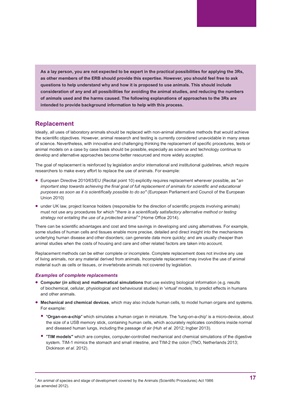
17
As a lay person, you are not expected to be expert in the practical possibilities for applying the 3Rs,
as other members of the ERB should provide this expertise. However, you should feel free to ask
questions to help understand why and how it is proposed to use animals. This should include
consideration of any and all possibilities for avoiding the animal studies, and reducing the numbers
of animals used and the harms caused. The following explanations of approaches to the 3Rs are
intended to provide background information to help with this process.
Replacement
Ideally, all uses of laboratory animals should be replaced with non-animal alternative methods that would achieve
the scientific objectives. However, animal research and testing is currently considered unavoidable in many areas
of science. Nevertheless, with innovative and challenging thinking the replacement of specific procedures, tests or
animal models on a case by case basis should be possible, especially as science and technology continue to
develop and alternative approaches become better resourced and more widely accepted.
The goal of replacement is reinforced by legislation and/or international and institutional guidelines, which require
researchers to make every effort to replace the use of animals. For example:
European Directive 2010/63/EU (Recital point 10) explicitly requires replacement wherever possible, as "an
important step towards achieving the final goal of full replacement of animals for scientific and educational
purposes as soon as it is scientifically possible to do so" (European Parliament and Council of the European
Union 2010)
under UK law, project licence holders (responsible for the direction of scientific projects involving animals)
must not use any procedures for which "there is a scientifically satisfactory alternative method or testing
strategy not entailing the use of a protected animal1
" (Home Office 2014).
There can be scientific advantages and cost and time savings in developing and using alternatives. For example,
some studies of human cells and tissues enable more precise, detailed and direct insight into the mechanisms
underlying human disease and other disorders; can generate data more quickly; and are usually cheaper than
animal studies when the costs of housing and care and other related factors are taken into account.
Replacement methods can be either complete or incomplete. Complete replacement does not involve any use
of living animals, nor any material derived from animals. Incomplete replacement may involve the use of animal
material such as cells or tissues, or invertebrate animals not covered by legislation.
Examples of complete replacements
Computer (in silico) and mathematical simulations that use existing biological information (e.g. results
of biochemical, cellular, physiological and behavioural studies) in 'virtual' models, to predict effects in humans
and other animals.
Mechanical and chemical devices, which may also include human cells, to model human organs and systems.
For example:
"Organ-on-a-chip" which simulates a human organ in miniature. The 'lung-on-a-chip' is a micro-device, about
the size of a USB memory stick, containing human cells, which accurately replicates conditions inside normal
and diseased human lungs, including the passage of air (Huh et al. 2012; Ingber 2013).
"TIM models" which are complex, computer-controlled mechanical and chemical simulations of the digestive
system. TIM-1 mimics the stomach and small intestine, and TIM-2 the colon (TNO, Netherlands 2013;
Dickinson et al. 2012).
1 An animal of species and stage of development covered by the Animals (Scientific Procedures) Act 1986
(as amended 2012).